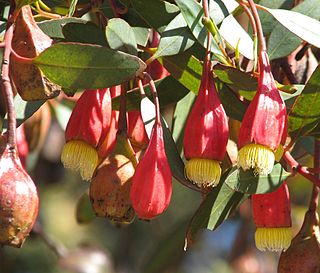
Eucalyptus forrestiana, commonly known as fuchsia gum or fuchsia mallee, is a species of small tree or mallet and is endemic to an area near Esperance, Western Australia. It has smooth grey bark, narrow oblong to lance-shaped adult leaves, flower buds that are square in cross-section, red at maturity and arranged singly in leaf axils, yellow flowers and four-angled, winged fruit.
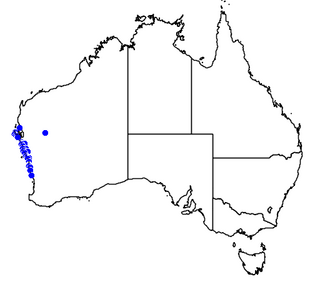
Commersonia borealis is a species of flowering plant in the family Malvaceae and is endemic to the southwest of Western Australia. It is a low growing, spreading shrub with egg-shaped to oblong leaves, and white, yellow and cream-coloured flowers.
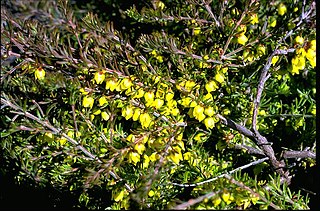
Boronia purdieana is a plant in the citrus family, Rutaceae and is endemic to the south-west of Western Australia. It is a shrub with pinnate leaves and yellow, four-petalled flowers arranged singly in leaf axils.

Philotheca deserti is a species of flowering plant in the family Rutaceae and is endemic to inland Western Australia. It is an erect shrub with narrow spindle-shaped, glandular-warty leaves and white flowers arranged singly in leaf axils.

Philotheca tomentella is a species of flowering plant in the family Rutaceae and is endemic to the south-west of Western Australia. It is an undershrub with small club-shaped to cylindrical leaves and white flowers with a pale red central stripe, arranged singly or in groups of up to four on the ends of branchlets.
Goodenia eremophila is a species of flowering plant in the family Goodeniaceae and is endemic to inland areas of Western Australia. It is an ascending herb with linear to elliptic leaves and thyrses of blue flowers.
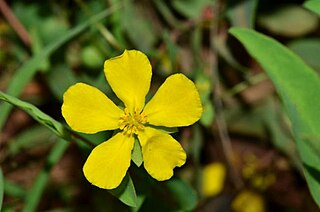
Hibbertia silvestris is a species of flowering plant in the family Dilleniaceae and is endemic to the south-west of Western Australia. It is a prostrate to more or less erect or spreading shrub with hairy young branchlets, elliptic to egg-shaped leaves with the narrower end towards the base and yellow flowers with seven to ten stamens on one side of two softly-hairy carpels.
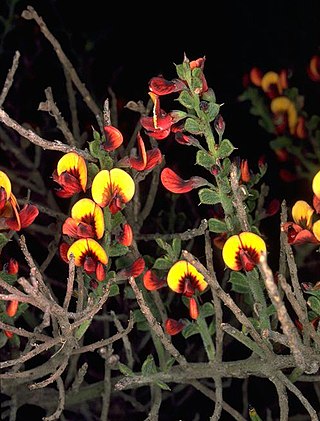
Daviesia dielsii, commonly known as Diels' daviesia, is a species of flowering plant in the family Fabaceae and is endemic to the south-west of Western Australia. It is on intricately-branched shrub with sharply-pointed, egg-shaped, vertically compressed phyllodes, and yellow and red flowers.
Lasiopetalum microcardium is a species of flowering plant in the family Malvaceae and is endemic to the south-west of Western Australia. It is a low, spreading or straggling shrub with hairy stems, heart-shaped leaves and blue, purple or white flowers.

Leucopogon cinereus is a species of flowering plant in the heath family Ericaceae and is endemic to the south-west of Western Australia. It is an erect, compact shrub that typically grows to a height of 0.3–1 m and has white flowers from August to October. It was first formally described in 1904 by Ernst Georg Pritzel in Botanische Jahrbücher für Systematik, Pflanzengeschichte und Pflanzengeographie from specimens collected on rocky hills near Gillingarra. The specific epithet (cinereus) means "grey", referring to the colour of the young stems and leaves.

Styphelia dielsiana is a species of flowering plant in the heath family Ericaceae and is endemic to the south-west of Western Australia. It was first formally described in 1904 by Ernst Georg Pritzel in Botanische Jahrbücher für Systematik, Pflanzengeschichte und Pflanzengeographie from specimens collected near Tammin. The specific epithet (dielsiana) honours Ludwig Diels.
Pimelea gilgiana is a species of flowering plant in the family Thymelaeaceae and is endemic to near-coastal areas of north-western Western Australia. It is a shrub with narrowly egg-shaped leaves and head-like clusters of white or pinkish, dioecious flowers.
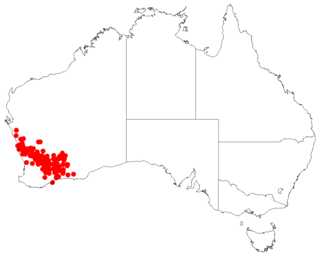
Styphelia hamulosa is a species of flowering plant in the heath family Ericaceae and is endemic to the south-west of Western Australia. It was first formally described in 1904 by Ernst Georg Pritzel who gave it the name Leucopogon hamulosus in Botanische Jahrbücher für Systematik, Pflanzengeschichte und Pflanzengeographie from specimens he collected near Mingenew. In 1963, Hermann Otto Sleumer transferred the species to Styphelia as S. hamulosa in the journal Blumea. The specific epithet (hamulosa) means "having small hooks" referring to the tips of the leaves.

Styphelia hispida is a species of flowering plant in the heath family Ericaceae and is endemic to the south-west of Western Australia. It was first formally described in 1904 by Ernst Georg Pritzel who gave it the name Leucopogon hispidus in Botanische Jahrbücher für Systematik, Pflanzengeschichte und Pflanzengeographie from specimens collected near Mingenew. In 1963, Hermann Otto Sleumer transferred the species to Styphelia as S. hispida in the journal Blumea. The specific epithet (hispida) means "with prickly hairs", referring to the leaves.
Thomasia dielsii is a species of flowering plant in the family Malvaceae and is endemic to the south-west of Western Australia. It is a low, erect to spreading shrub with egg-shaped leaves with wavy edges, and purple, violet and blue flowers.
Thomasia multiflora is a species of flowering plant in the family Malvaceae and is endemic to the south-west of Western Australia. It is a low, spreading shrub with broadly egg-shaped leaves and mauve flowers.

Leucopogon mollis is a species of flowering plant in the heath family Ericaceae and is endemic to the south-west of Western Australia. It is a slender, diffuse shrub that typically grows to a height of 0.3–1 m and has white, tube-shaped flowers. The species was first formally described in 1904 by Ernst Georg Pritzel in Botanische Jahrbücher für Systematik, Pflanzengeschichte und Pflanzengeographie from specimens collected on the summit of "Mount Mongerup" in the Stirling Range. The specific epithet (mollis) means "soft".
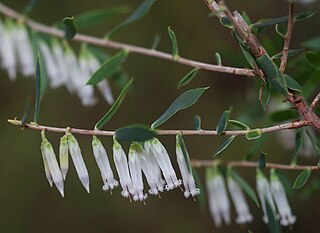
Styphelia nitens is a species of flowering plant in the heath family Ericaceae and is endemic to the south-west of Western Australia. It is a shrub that was first formally described in 1904 by Ernst Georg Pritzel in Botanische Jahrbücher für Systematik, Pflanzengeschichte und Pflanzengeographie from specimens collected in Darlington. In 1964, Hermann Otto Sleumer transferred the species to Styphelia, but since the name S. nutans referred to a different species the new species was given the name S. nitens. The original specific epithet (nutans) means "nodding".

Leucopogon psammophilus is a species of flowering plant in the heath family Ericaceae and is endemic to the south-west of Western Australia. It is a shrub that typically grows to a height of 45 cm (18 in) and grows on breakaways in the Geraldton Sandplains bioregion of south-western Western Australia. The species was first formally described in 1904 by Ernst Georg Pritzel in Botanische Jahrbücher für Systematik, Pflanzengeschichte und Pflanzengeographie from specimens collected near the Greenough River. It is listed as "Priority One" by the Government of Western Australia Department of Biodiversity, Conservation and Attractions, meaning that it is known from only one or a few locations which are potentially at risk.

Styphelia decussata is a species of flowering plant in the heath family Ericaceae and is endemic to the south-west of Western Australia.















